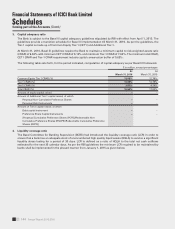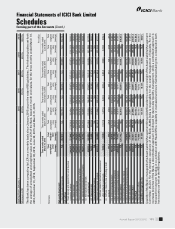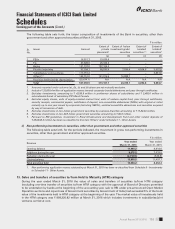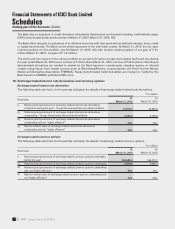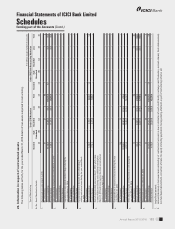ICICI Bank 2016 Annual Report Download - page 156
Download and view the complete annual report
Please find page 156 of the 2016 ICICI Bank annual report below. You can navigate through the pages in the report by either clicking on the pages listed below, or by using the keyword search tool below to find specific information within the annual report.
Annual Report 2015-2016154
Schedules
forming part of the Accounts (Contd.)
Financial Statements of ICICI Bank Limited
14. CBLO transactions
Collateralised Borrowing and Lending Obligation (CBLO) is a discounted money market instrument, established by
The Clearing Corporation of India Limited (CCIL) and approved by RBI, which involves secured borrowings and
lending transactions. At March 31, 2016, the Bank had no outstanding borrowings (March 31, 2015: Nil) and no
outstanding lending (March 31, 2015: Nil) in the form of CBLO. The amortised book value of securities given as
collateral by the Bank to CCIL for availing the CBLO facility was ` 68,296.0 million at March 31, 2016 (March 31, 2015:
` 84,853.6 million).
15. Derivatives
The Bank is a major participant in the nancial derivatives market. The Bank deals in derivatives for balance sheet
management, proprietary trading and market making purposes whereby the Bank offers derivative products to its
customers, enabling them to hedge their risks.
Dealing in derivatives is carried out by identied groups in the treasury of the Bank based on the purpose of the
transaction. Derivative transactions are entered into by the treasury front ofce. Treasury Control and Service Group
(TCSG) conducts an independent check of the transactions entered into by the front ofce and also undertakes
activities such as conrmation, settlement, accounting, risk monitoring and reporting and ensures compliance with
various internal and regulatory guidelines.
The market making and the proprietary trading activities in derivatives are governed by the Investment policy and
Derivative policy of the Bank, which lays down the position limits, stop loss limits as well as other risk limits. The
Risk Management Group (RMG) lays down the methodology for computation and monitoring of risk. The Risk
Committee of the Board (RCB) reviews the Bank’s risk management policy in relation to various risks including credit
and recovery policy, investment policy, derivative policy, Asset Liability Management (ALM) policy and operational
risk management policy. The RCB comprises independent directors and the Managing Director and CEO.
The Bank measures and monitors risk of its derivatives portfolio using such risk metrics as Value at Risk (VAR), stop
loss limits and relevant greeks for options. Risk reporting on derivatives forms an integral part of the management
information system.
The use of derivatives for hedging purposes is governed by the hedge policy approved by Asset Liability Management
Committee (ALCO). Subject to prevailing RBI guidelines, the Bank deals in derivatives for hedging xed rate, oating
rate or foreign currency assets/liabilities. Transactions for hedging and market making purposes are recorded
separately. For hedge transactions, the Bank identies the hedged item (asset or liability) at the inception of the hedge
itself. The effectiveness is assessed at the time of inception of the hedge and periodically thereafter.
Hedge derivative transactions are accounted for pursuant to the principles of hedge accounting based on guidelines
issued by RBI. Derivatives for market making purpose are marked to market and the resulting gain/loss is recorded
in the prot and loss account. The premium on option contracts is accounted for as per Foreign Exchange Dealers
Association of India (FEDAI) guidelines.
Over the counter (OTC) derivative transactions are covered under International Swaps and Derivatives Association
(ISDA) master agreements with the respective counter parties. The exposure on account of derivative transactions is
computed as per RBI guidelines.


